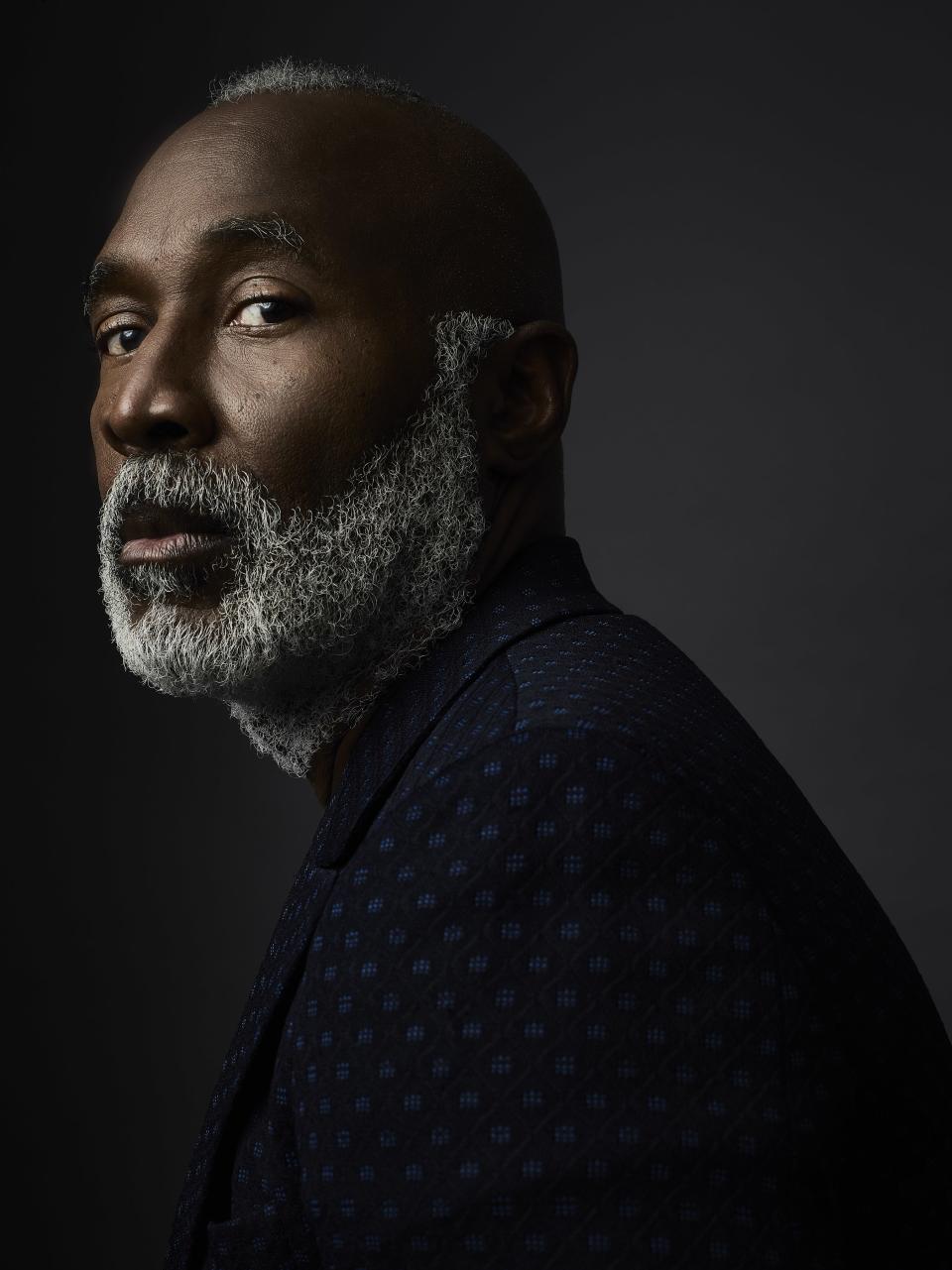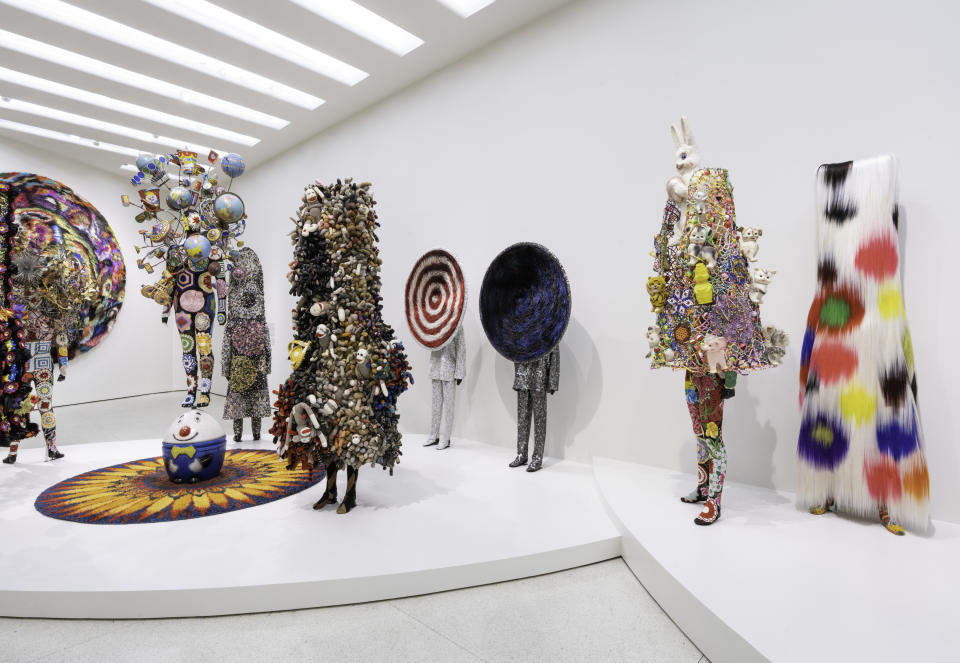Nick Cave’s Career Retrospective at the Guggenheim Stretches Well Beyond the Soundsuit

Nick Cave is far more than the Soundsuits most know him for.
And the visual artist and conscious creator has the span of his career’s work on display in the newly opened exhibit, “Forothermore” at the Guggenheim Museum in New York, which follows a stint at the Museum of Contemporary Art Chicago, the city Cave calls home.
More from WWD
A Look at Artist Yvette Mayorga's Most Recent Show at The Momentary
Inside Charisse Pearlina Weston's Solo Exhibition at the Queens Museum
A walk through Cave’s unending efforts to bring light to injustice and “othered” people — through textile work, painting, sculpture and more — “Forothermore” is about honoring the past, recognizing the present and looking ahead to what’s next.
“I’m always thinking about what is my responsibility to get the work out into the community and creating avenues and ways to bring underserved communities into the mix. And just thinking more about the civic responsibility of that as a human being. ‘Forothermore,’ it’s for others, it’s inclusive, it means all and it’s a moment that I feel is important right now particularly,” the artist says. “And it’s something that it’s important period. I really want this experience to be colorful.”
And colorful it is.
Installed throughout the Guggenheim’s tower galleries and overseen by Naomi Beckwith, the museum’s deputy director and Jennifer and David Stockman chief curator — who is making her curatorial debut in this role with “Forothermore” — the retrospective is delivered in three parts. In line with an old African American greeting, “What it Was,” “What it Is,” and “What it Shall Be” display Cave’s past, present and future-facing work, alongside the past, present and future-facing realities of the world we live in.
“I’ve always worked in this space of sort of a call and response to what’s going on in the world, but at the same time finding [that] through beauty, which has always been my form of rebelling, has allowed me to create ways in which you can immerse yourself in the practice and I can take you on this amazing journey,” Cave says.

‘What It Was’
Entering the exhibit first through the past in order to see where we’ve been — at least as it appears through Cave’s eyes — visitors begin with a lesson in seeing beyond what one artist may be most famous for and will come to understand that the breadth of Cave’s work has long been waving the flag for equality.
“You see all of this work that no one will ever connect me to because everyone knows me as Soundsuits, that being the body of work. But there’s all of this work that came before that,” the artist says.
The work “Platform” is a favorite of Cave’s.
“There’s a piece titled ‘Platform’ that is really a very powerful piece that could be read in two ways: It could be a resist or it can be a protest, a coming together and it’s very amplified through shape and form,” Cave says.
“And then there’s the ‘Hustle Coat’ that’s on that same sort of floor, which is this amazing trenchcoat that’s just covered in jewels and just surplus, this abundance of stones, and it’s very decorative, it’s very bright, but it’s all about the hustle,” he adds.
With “Forothermore,” Cave wants to send a message of beauty in the struggle. Regardless of how one sees the pieces, it’s really more about how they’ll feel when experiencing them. And his pieces have power in a similar way that the social movements and struggles they reflect have power.
“It’s a lot of mixed emotions that are all colliding together, but at the same time I’m operating in this space of optimism and hope and that’s always been the driving force. As a young Black man growing up, I was always told that, ‘you are amazing, you’re beautiful, you can be and do anything that you want.’ And I was very much told that these are things you must be aware of, but…be cautioned of what you may run up against [in the world],” he says.
‘What It Is’
“What It Is,” alongside the art, comes with a reality of a world in too many ways still unchanged when it comes to racism and injustice.
In his own journey in bringing this exhibit together with Beckwith over the last three years, which included the murder of George Floyd in 2020 and had an impact on the way Cave saw himself and his work, the artist was able to see his own patterns.
“It was interesting for me to spend three years working with Naomi Beckwith and putting this together and really understanding that for three and a half decades I’ve been trying to bring light to the subject of racism, injustice, inequality” Cave says. “I know that I am triggered by what’s happening socially in the world but to be able to see that commitment and purpose was really an incredible moment. But then through that also trying to find ways to reconciliate these emotions. I have to, somehow in the trauma of it all, find peace and this sort idea of moving forward.
“Going forward, it’s all about Black excellence first. And then when something appears [in the social landscape] I will incorporate it into the moment.”
A painting titled “Sea Sick” is one piece to watch for in “What It Is,” and one Cave believes well illustrates the idea of moving forward in the face of trauma.

Scouting for materials on one of his cross-country antique and flea market runs, the artist happened upon something that inspired its own body of work on display in the exhibit.
“[It] was a bust of a Black man’s head and it was a container of sorts. I thought it was interesting, I pulled it off the shelf and it said ‘spittoon.’ I was just livid in that moment,” Cave says. “But it really triggered this whole body of work of traveling and finding the most repulsive objects and thinking about how racism has found its way into consumerism and product.”
‘What It Shall Be’
“What It Shall Be” is where the museum hosts 16 of Cave’s famed Soundsuits.
The Soundsuit, created first in 1992 as an artful yet provoking response to the Rodney King beating, saw Cave exploring, as a Black man, what it means to “feel dismissed, discarded, viewed [as] less than,” he says in a 2018 Smithsonian video interview. Mulling that all in the park one day, he saw a twig appearing similarly dismissed and discarded, and started to collect them. The twigs found their way into his studio, taking form as a sculpture and ultimately a garment that, once worn, made a sound that gave the suits their name.
But it was the anonymity that the part sculpture, part costume Soundsuits created that serves as the response to the racial profiling Cave was responding to. In a Soundsuit, the wearer isn’t recognizable by race, size, gender or any other commonly discriminated characteristic. He explores what it would mean in the world to appear like this.

Since then the artist has created more than 500 Soundsuits, crafted mostly from discarded materials or thrift-store finds, made with elaborate textile pieces, multihued shaggy substances and anything else that compels Cave for inclusion. Striking in both their stature and intricacy, the Soundsuits are by far the most colorful of the “Forothermore” experience.
“The reference point becomes universal,” he explains. “I could be looking at Haitian Voodoo flags or I could be at Carnival or it’s the Mardi Gras Indians or maybe it’s the Egungun [a Yoruba masquerade for ancestor reverence], and maybe George Clinton. It’s looking at everything that finds its way into this whole idea of abundance and heightened sensation.”
The Soundsuits, always life-size or larger, always intricately crafted, sometimes steady as sculptures in museums and sometimes human-inhabited and brought to life through performance and dance, have been inspired by — and have likewise inspired — fashion, according to Cave.
When it comes to the former, Cave likens Soundsuits to couture in terms of craft.
“We can look at couture in terms of ways in which things are constructed, the ways in which things are built, the level of adornment, embellishment, construction, how things are put together,” he says. “The infrastructures of what supports some of these shapes and forms and just the physical handwork in building a sculpture. It’s not that anything is just two dimensional. Cloth becomes three dimensional. So it’s really about building with the proper principles of how to construct and build a garment.”
Earlier this year, as evidence of the Soundsuits inspiring fashion, Cave created an 80-look fashion collection, which debuted at Chicago’s DuSable Museum of African American History, as a result of what he labeled a “call and response” to the Soundsuits’ impact. Those pieces will appear in a fashion film titled “The Color Is, 137 Days,” which will premiere at the Guggenheim in February, though the garments themselves won’t be part of the exhibit.
What will be part of the exhibit, are pieces from “the beginning of a new body of work titled ‘Soundsuit 2.0,'” Cave says.
“[These] really started right before [the murder of] George Floyd happened and then when [it] happened that whole idea was then covered in a black veil of sorts, so those are in the show,” he says. “But at the same time, I just completed my first 12-foot bronze Soundsuit [also not on display at ‘Forothermore’ because, in Cave’s words, ‘it didn’t fit through the door].’ So now I’m thinking about bronze and thinking about public space and again thinking of the ways in which it could find its way out of institutions into public spaces. At the same time, the dismantling of monuments was coming down, so it’s all sort of this transition of the was, the new and the rise of the phoenix.”
“Forothermore” is on exhibit at the Guggeheim will run through April 10.
The ideal audience for Cave?
“Everyone,” he says, adding, “As an artist, museums should be accessible to everyone. At the end of the day I mean, that’s why they’re here.”
For Beckwith, “Forothermore” has been just the right foray.
“When I took on this amazing position at the Guggenheim, I knew it would be important to signal my values for my first show,” she says. “Nick and his work is the perfect encapsulation of the things I care deeply for: championing the marginalized, valuing art that intersects with performance and social life, celebrating art from the center of the country. But above all, his work and mine acknowledges that there is a lot of love, joy and beauty in our Black communities, even in the face of hate and violence. We simply want to share that joy.”

“Soundsuits.” Installation view, Nick Cave: Forothermore, Solomon R. Guggenheim Museum, November 18, 2022–April 10, 2023. © Solomon R. Guggenheim Foundation, New York. Photo: Ariel Ione Williams.
Best of WWD


